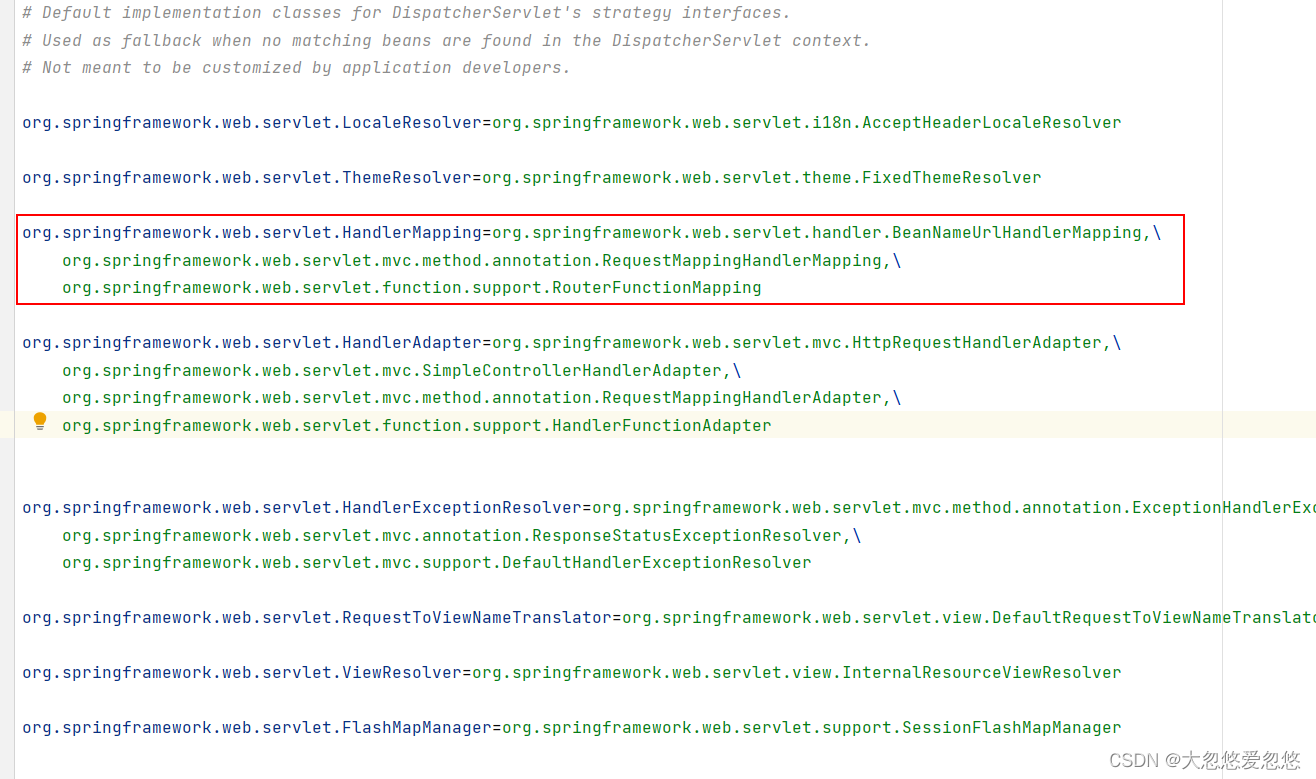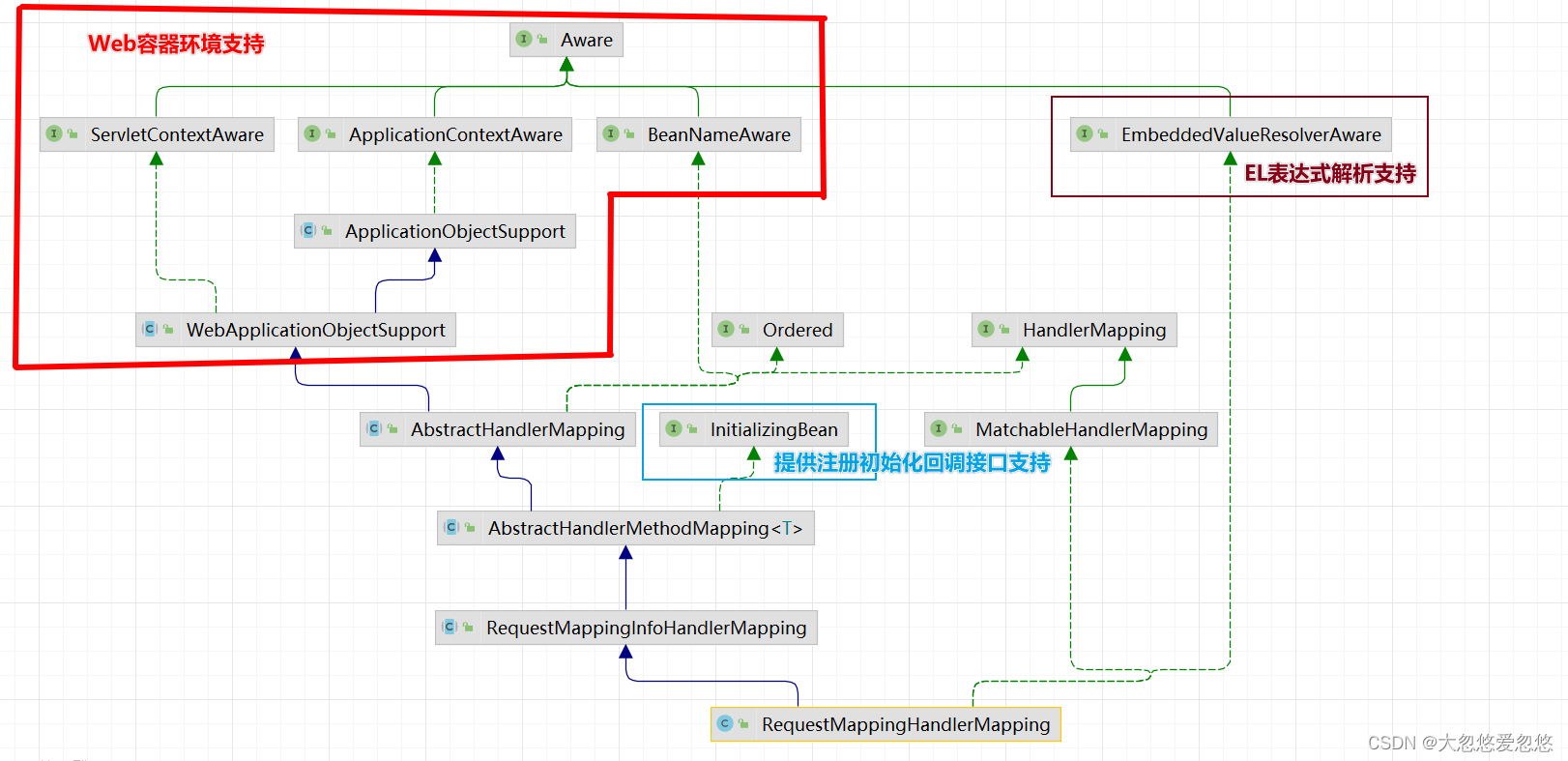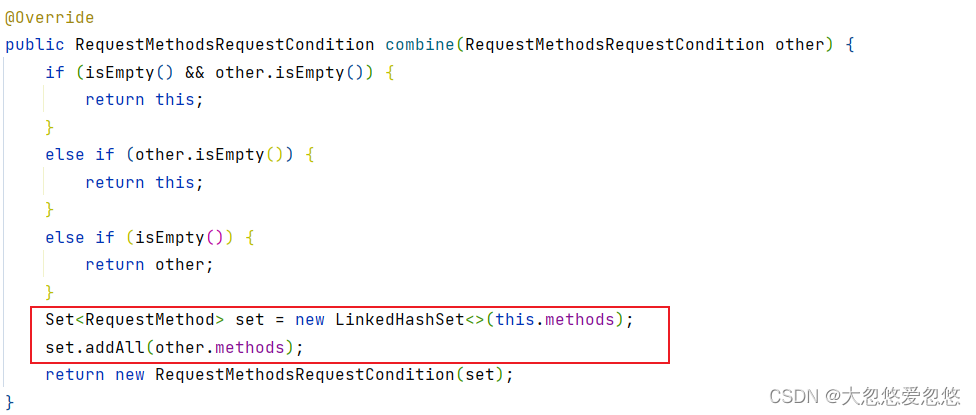目录
在springMVC阶段中,对各个流程已经很熟悉了,下面再来深究一下细节。
本文主要讲解拦截器和请求映射的建立和处理
根据以前自定义springmvc的基础条件中,可以知道我们的创建条件无非以下几个步骤:
- 1、先扫描上下文;
- 2、判断类和方法上是否存在着对应的注解,并将信息进行封装;
- 3、添加映射;
- 4、请求过来时,根据条件来处理请求;
所以猜想以下springmvc中应该也是这样子来进行实现的,无非是功能实现上丰富一点。
1、引言
DispatcherServlet通过SPI机制来加载默认提供的相关组件,而SPI的核心就在于DispathcerServlet.properties文件:

该文件内部列举了各个组件会提供哪些默认实现,使用这些默认实现的前提是,DispathcerServlet在初始化各个组件时,并没有在当前容器内发现各个组件已有的实现。[参考对应的配置类]
Controller的寻找是通过HandlerMapping完成的,而调用则是通过HandlerAdaptor完成的。
对于注解版本Controller寻找是通过RequestMappingHandlerMapping完成的,RequestMappingHandlerMapping主要负责在自身初始化阶段搜寻出当前容器内所有可用Controller实现,然后建立相关映射关系; 在请求到来时,再通过这些映射关系寻找到对应处理方法后返回。
对于注解版本的Controller请求处理方法调用是通过RequestMappingHandlerAdapter完成的,RequestMappingHandlerAdapter负责拿到RequestMappingHandlerMapping返回的方法后,进行一系列处理后,调用目标方法处理请求,这一系列处理包括: 数据绑定和数据校验,返回值处理等等…
整个注解版本Controller源码解析流程较为繁琐,但是大体上还是分为两个阶段:
-
映射建立
-
处理请求
因此,本节先分析前半部分,即RequestMappingHandlerMapping是如何建立映射关系的
2、RequestMappingHandlerMapping
类图分析:

-
AbstractHandlerMapping:提供基础设施支持,例如: 路径解析,拦截器,跨域。 规定了根据request得到handler的模板方法处理流程getHandler,具体如何根据request寻找到某个handler,则是由子类实现。
-
AbstractHandlerMethodMapping:囊括了对注解Controller寻找,建立映射和根据request找到对应handler的流程支持,核心在于建立Reuqest和HandlerMethod的映射关系,将识别处理器方法和建立映射的任务交给子类实现。
-
RequestMappingHandlerMapping:核心在于解析处理器方法和对应Controller上@RequestMapping注解,然后合并生成一个RequestMappingInfo作为映射的关键一环返回。
建立映射
首先肯定是需要有一个扫描环节的。那么直接看一下springMVC中提供的扫描环节。
Reuqest和HandlerMethod的映射的建立过程由AbstractHandlerMethodMapping实现的初始化回调接口afterPropertiesSet完成:
而实际上,另外一个接口也很重要:ApplicationContextAware中的setApplicationContext方法
// Handler method detection
/**
* Detects handler methods at initialization.
* @see #initHandlerMethods
*/
@Override
public void afterPropertiesSet() {
initHandlerMethods();
}
看方法注释:查找得到Handlermethod
initHandlerMethods是映射建立的入口,我们需要深入其中:
protected void initHandlerMethods() {
//getCandidateBeanNames可以简单的理解为是获取当前容器内部的所有bean实例
for (String beanName : getCandidateBeanNames()) {
...
//需要判断当前bean是不是我们需要的候选bean,如果是就进行处理
processCandidateBean(beanName);
}
//简单的日志记录
handlerMethodsInitialized(getHandlerMethods());
}
这里的前提是:controller已经成为bean了,然后才会去获取得到对应的bean的name。这个是一个大前提。
processCandidateBean是核心方法,该方法内部完成了bean的筛选和对某个Controller内部所有handlerMethod的探测。
protected void processCandidateBean(String beanName) {
Class<?> beanType = null;
//获取当前bean类型
beanType = obtainApplicationContext().getType(beanName);
..
//默认AbstractHandlerMethodMapping是不提供对处理器的识别的,具体如何识别某个bean是不是handler,是由子类决定的
//这里是AbstractHandlerMethodMapping实现的,筛选规则如下:
//检验当前bean上是否存在Controller或者RequestMapping注解
if (beanType != null && isHandler(beanType)) {
//如果当前bean是一个handler,那么需要探测出该handler内部所有handlerMethod实现
detectHandlerMethods(beanName);
}
}
然后判断是否是controller中类型,判断条件是:isHandler
protected boolean isHandler(Class<?> beanType) {
return (AnnotatedElementUtils.hasAnnotation(beanType, Controller.class) ||
AnnotatedElementUtils.hasAnnotation(beanType, RequestMapping.class));
}
判断类上是否有Controller注解或者是RequestMapping注解。
这里说明了什么?说明了不管是Controller注解还是RequestMapping注解,都是由潜在的可能会存在着HandlerMethod。
但是因为编码习惯,通常认为MVC中的C表示的是controller层,只做参数处理和转发。我们不会在service层面和dao层面上来写Controller注解和RequestMapping注解
handlerMethod才是处理请求的终点,因此我们需要探测当前handler内部有哪些handlerMethod,并且建立好相关映射关系:
开始来查找对应的HandlerMethod,这里的查找是遍历每个类,查看类中的HandlerMethod
protected void detectHandlerMethods(Object handler) {
//先获取到当前handler的type
Class<?> handlerType = (handler instanceof String ?
obtainApplicationContext().getType((String) handler) : handler.getClass());
if (handlerType != null) {
//如果当前handler是被cglib代理过的对象,那么需要获取当前代理对象的superClass
//因为这才是目标handler的类型
Class<?> userType = ClassUtils.getUserClass(handlerType);
//MethodIntrospector类主要提供对方法的筛选和通用处理封装
//这里selectMethods就是筛选出当前handler内部所有符合要求的handlerMethod
Map<Method, T> methods = MethodIntrospector.selectMethods(userType,
//筛选出某个handlerMethod,利用注册的回调接口生成映射关系
(MethodIntrospector.MetadataLookup<T>) method -> {
try {
return getMappingForMethod(method, userType);
}
catch (Throwable ex) {
throw new IllegalStateException("Invalid mapping on handler class [" +
userType.getName() + "]: " + method, ex);
}
});
...
methods.forEach((method, mapping) -> {
//对jdk动态代理的情况进行处理--一般情况下可以忽略,因此controller层一般都是采用cglib代理
Method invocableMethod = AopUtils.selectInvocableMethod(method, userType);
//注册
registerHandlerMethod(handler, invocableMethod, mapping);
});
}
}
MethodIntrospector.selectMethods作用可以简单看做是遍历handler类内部所有方法,包括其父类和实现接口里面的所有方法,然后交给注册进来的回调接口进行处理,回调接口的返回值作为生成的映射信息,如果返回值不为空,就和当前method组成一条记录,放入map中; 遍历完所有方法后,返回该map集合。
selectMethods完成方法筛选的关键就在于目标方法经过回调接口处理过后,返回值是否为空,如果为空,说明当前方法需要被过滤掉
所以,上面注册的回调接口中的getMappingForMethod方法才是我们需要关注的重点,该方法完成了对当前method信息的提取,最终组装返回一个请求映射信息。
和上面识别handler一样,具体是如何完成对method解析的过程,也是由RequestMappingHandlerMapping子类实现的。
3、解析handlerMethod
protected RequestMappingInfo getMappingForMethod(Method method, Class<?> handlerType) {
//根据当前方法,创建一个请求映射信息
RequestMappingInfo info = createRequestMappingInfo(method);
//如果当前方法并没有标注@RequestMapping等注解,那么也就不是一个handlerMethod,那么就返回null
//该方法就会在selectMethods中被过滤掉
if (info != null) {
//当前handlerMethod属于的handler上是否也存在@RequestMapping注解,如果存在就解析
RequestMappingInfo typeInfo = createRequestMappingInfo(handlerType);
if (typeInfo != null) {
//如果handler上确实存在,那么就需要将方法上的@RequestMapping注解和类上的@RequestMapping注解注解进行合并
info = typeInfo.combine(info);
}
//关于前缀的问题,下一节会展开讲,这里先跳过
String prefix = getPathPrefix(handlerType);
if (prefix != null) {
info = RequestMappingInfo.paths(prefix).options(this.config).build().combine(info);
}
}
return info;
}
createRequestMappingInfo方法会对传入的AnnotatedElement上的RequestMapping注解进行解析,然后生成RequestMappingInfo返回。
AnnotatedElement是JDK反射包提供的顶层接口,实现了该接口的元素,都是可以标注注解的元素,例如: Class,Method,Parameter等都实现了该接口
private RequestMappingInfo createRequestMappingInfo(AnnotatedElement element) {
//拿到当前元素上的注解信息
RequestMapping requestMapping = AnnotatedElementUtils.findMergedAnnotation(element, RequestMapping.class);
//用户可以实现相关方法来创建自定义的请求匹配条件
RequestCondition<?> condition = (element instanceof Class ?
getCustomTypeCondition((Class<?>) element) : getCustomMethodCondition((Method) element));
return (requestMapping != null ?
//如果存在注解,就创建对应的RequestMappingInfo
createRequestMappingInfo(requestMapping, condition) : null);
}
注意
重点:自定义实现请求路径匹配条件
后续可以针对于各种各样的请求匹配规则来进行操作。
RequestMappingInfo可以看出,就是@RequestMapping注解对应信息的实体载体。
protected RequestMappingInfo createRequestMappingInfo(
RequestMapping requestMapping, @Nullable RequestCondition<?> customCondition) {
RequestMappingInfo.Builder builder = RequestMappingInfo
//requestMapping注解中的path属性会经过EL解析器解析,也就是我们在路径中可以通过el表达式获取上下文中的值
//例如: ${user.dir}
.paths(resolveEmbeddedValuesInPatterns(requestMapping.path()))
//通过请求方式限制匹配
.methods(requestMapping.method())
//通过请求参数中必须携带某个请求参数进行限制匹配
.params(requestMapping.params())
//通过请求头中必须携带某个请求头进行限制匹配
.headers(requestMapping.headers())
//通过限制请求头中的content-type来进行限制匹配
.consumes(requestMapping.consumes())
//规定响应的content-type类型
.produces(requestMapping.produces())
// 映射名称
.mappingName(requestMapping.name());
//是否存在用户自定义匹配限制
if (customCondition != null) {
builder.customCondition(customCondition);
}
//构建RequestMappingInfo后返回
return builder.options(this.config).build();
}
4、@RequestMapping注解
@RequestMapping注解中各个属性含义详解如下:
// @since 2.5 用于将Web请求映射到具有灵活方法签名的请求处理类中的方法的注释 Both Spring MVC and `Spring WebFlux` support this annotation
// @Mapping这个注解是@since 3.0 但它目前还只有这个地方使用到了~~~ 我感觉是多余的
@Target({ElementType.METHOD, ElementType.TYPE}) // 能够用到类上和方法上
@Retention(RetentionPolicy.RUNTIME)
@Documented
@Mapping
public @interface RequestMapping {
//给这个Mapping取一个名字。若不填写,就用HandlerMethodMappingNamingStrategy去按规则生成
String name() default "";
// 路径 数组形式 可以写多个。 一般都是按照Ant风格进行书写~
@AliasFor("path")
String[] value() default {};
@AliasFor("value")
String[] path() default {};
// 请求方法:GET, HEAD, POST, PUT, PATCH, DELETE, OPTIONS, TRACE
// 显然可以指定多个方法。如果不指定,表示适配所有方法类型~~
// 同时还有类似的枚举类:org.springframework.http.HttpMethod
RequestMethod[] method() default {};
// 指定request中必须包含某些参数值时,才让该方法处理
// 使用 params 元素,你可以让多个处理方法处理到同一个URL 的请求, 而这些请求的参数是不一样的
// 如:@RequestMapping(value = "/fetch", params = {"personId=10"} 和 @RequestMapping(value = "/fetch", params = // {"personId=20"}
// 这两个方法都处理请求`/fetch`,但是参数不一样,进入的方法也不一样~~~~
// 支持!myParam和myParam!=myValue这种~~~
String[] params() default {};
// 指定request中必须包含某些指定的header值,才能让该方法处理请求
// @RequestMapping(value = "/head", headers = {"content-type=text/plain"}
String[] headers() default {};
// 指定处理请求request的**提交内容类型**(Content-Type),例如application/json、text/html等
// 相当于只有指定的这些Content-Type的才处理
// @RequestMapping(value = "/cons", consumes = {"application/json", "application/XML"}
// 不指定表示处理所有~~ 取值参见枚举类:org.springframework.http.MediaType
// 它可以使用!text/plain形如这样非的表达方式
String[] consumes() default {};
// 指定返回的内容类型,返回的内容类型必须是request请求头(Accept)中所包含的类型
// 仅当request请求头中的(Accept)类型中包含该指定类型才返回;
// 参见枚举类:org.springframework.http.MediaType
// 它可以使用!text/plain形如这样非的表达方式
String[] produces() default {};
}
Spring4.3之后提供了组合注解5枚:
@GetMapping
@PostMapping
@PutMapping
@DeleteMapping
@PatchMapping
consumes 与 headers 区别
- consumes 、produces 、params、 headers四个属性都是用来缩小请求范围。
- consumes只能指定 content-Type 的内容类型,但是headers可以指定所有。
所以可以认为:headers是更为强大的(所有需要指定key和value嘛),而consumes和produces是专用的,头的key是固定的,所以只需要写value值即可,使用起来也更加的方便~。
推荐两个类
- org.springframework.http.HttpHeaders,它里面有常量:几乎所有的请求头的key,以及我们可以很方便的构建一个HttpHeader,平时可以作为参考使用
- org.springframework.http.MediaType,几乎支持所有的媒体类型,无论是请求的还是响应的媒体类型
合并定义
protected RequestMappingInfo getMappingForMethod(Method method, Class<?> handlerType) {
//根据当前方法,创建一个请求映射信息
RequestMappingInfo info = createRequestMappingInfo(method);
//如果当前方法并没有标注@RequestMapping等注解,那么也就不是一个handlerMethod,那么就返回null
//该方法就会在selectMethods中被过滤掉
if (info != null) {
//当前handlerMethod属于的handler上是否也存在@RequestMapping注解,如果存在就解析
RequestMappingInfo typeInfo = createRequestMappingInfo(handlerType);
if (typeInfo != null) {
//如果handler上确实存在,那么就需要将方法上的@RequestMapping注解和类上的@RequestMapping注解注解进行合并
info = typeInfo.combine(info);
}
...
}
return info;
}
如果当前handleMethod对应的Handler上也存在@RequestMapping注解,那么就需要将类上的提供的@RequestMapping注解信息,与当前类内部所有handlerMethod提供的@RequestMapping注解信息进行合并,具体合并规则如下:
请求路径就是拼接:
@RequestMapping("/admin")
@RestController
public class AdminController {
@PostMapping("/login")
public Result login(){
...
}
}
HandlerMethod这里对应的就是login方法,而Handler对应的就是AdminController,此时合并完之后,得到的RequestMappingInfo 中的path路径为/admin/login。
其他属性就是简单的合并


5、注册HandlerMethod
protected void detectHandlerMethods(Object handler) {
//先获取到当前handler的type
Class<?> handlerType = (handler instanceof String ?
obtainApplicationContext().getType((String) handler) : handler.getClass());
if (handlerType != null) {
//如果当前handler是被cglib代理过的对象,那么需要获取当前代理对象的superClass
//因为这才是目标handler的类型
Class<?> userType = ClassUtils.getUserClass(handlerType);
//MethodIntrospector类主要提供对方法的筛选和通用处理封装
//这里selectMethods就是筛选出当前handler内部所有符合要求的handlerMethod
Map<Method, T> methods = MethodIntrospector.selectMethods(userType,
//筛选出某个handlerMethod,利用注册的回调接口生成映射关系
(MethodIntrospector.MetadataLookup<T>) method -> {
try {
return getMappingForMethod(method, userType);
}
catch (Throwable ex) {
throw new IllegalStateException("Invalid mapping on handler class [" +
userType.getName() + "]: " + method, ex);
}
});
...
methods.forEach((method, mapping) -> {
//对jdk动态代理的情况进行处理--一般情况下可以忽略,因此controller层一般都是采用cglib代理
Method invocableMethod = AopUtils.selectInvocableMethod(method, userType);
//注册
registerHandlerMethod(handler, invocableMethod, mapping);
});
}
}
MethodIntrospector.selectMethods通过getMappingForMethod回调接口筛选出相关方法,并且建立好Method和对应RequestMappingInfo 映射关系后,返回了一个map集合,下面就是需要将这些映射关系进行注册。
子类RequestMappingHandlerMapping重写了父类的registerHandlerMethod方法,主要提供了对ConsumesCondition扩展点的支持:
@Override
protected void registerHandlerMethod(Object handler, Method method, RequestMappingInfo mapping) {
super.registerHandlerMethod(handler, method, mapping);
updateConsumesCondition(mapping, method);
}
这里,我们先将目光着眼于父类AbstractHandlerMethodMapping提供的registerHandlerMethod实现:
protected void registerHandlerMethod(Object handler, Method method, T mapping) {
this.mappingRegistry.register(mapping, handler, method);
}
MappingRegistry映射注册中心
MappingRegistry是AbstractHandlerMethodMapping内部维护的一个映射关系的注册中心:
class MappingRegistry {
//保存RequestMappingInfo和MappingRegistration的映射关系
private final Map<T, MappingRegistration<T>> registry = new HashMap<>();
//保存请求路径和RequestMappingInfo的映射关系
private final MultiValueMap<String, T> pathLookup = new LinkedMultiValueMap<>();
//保存handlerMethodName和handlerMethod的映射关系
private final Map<String, List<HandlerMethod>> nameLookup = new ConcurrentHashMap<>();
//保存handlerMethod和跨域配置的映射关系
private final Map<HandlerMethod, CorsConfiguration> corsLookup = new ConcurrentHashMap<>();
//读写锁
private final ReentrantReadWriteLock readWriteLock = new ReentrantReadWriteLock();
...
看下具体的过程,考虑到并发修改注册中心带来的安全性,这里采用了写锁:
//mapping就是handlerMethod对应的RequestMappingInfo
//然后是handler和handlerMethod
//ps:这里的handlerMethod指的是handler中的处理请求方法
public void register(T mapping, Object handler, Method method) {
this.readWriteLock.writeLock().lock();
try {
//对原生处理请求方法进行了一层封装,包装为了一个HandlerMethod
HandlerMethod handlerMethod = createHandlerMethod(handler, method);
//进行映射校验,判断是否存在模糊映射,即一个请求URL可以同时被多个handlerMethod处理
validateMethodMapping(handlerMethod, mapping);
//从RequestMappingInfo中获取当前handlerMethod能够处理的请求URL集合
Set<String> directPaths = AbstractHandlerMethodMapping.this.getDirectPaths(mapping);
//将请求路径和RequestMappingInfo的映射关系添加到pathLookUp集合中保存
for (String path : directPaths) {
this.pathLookup.add(path, mapping);
}
// 为HandlerMethod的映射分配名称
// 默认采用:RequestMappingInfoHandlerMethodMappingNamingStrategy 策略来分配名称
// 策略为:@RequestMapping指定了name属性,那就以指定的为准 否则策略为:取出Controller所有的`大写字母` + # + method.getName()
// 如:AppoloController#match方法 最终的name为:AC#match
String name = null;
if (getNamingStrategy() != null) {
name = getNamingStrategy().getName(handlerMethod, mapping);
addMappingName(name, handlerMethod);
}
//处理方法上的CrossOrigin跨域注解---这个后面讲到跨域问题的时候再说,本文不展开
CorsConfiguration corsConfig = initCorsConfiguration(handler, method, mapping);
if (corsConfig != null) {
corsConfig.validateAllowCredentials();
this.corsLookup.put(handlerMethod, corsConfig);
}
//注册---这里是RequestMappingInfo和封装后的MappingRegistration的映射
this.registry.put(mapping,
new MappingRegistration<>(mapping, handlerMethod, directPaths, name, corsConfig != null));
}
finally {
//释放写锁
this.readWriteLock.writeLock().unlock();
}
}
createHandlerMethod
protected HandlerMethod createHandlerMethod(Object handler, Method method) {
if (handler instanceof String) {
return new HandlerMethod((String) handler,
obtainApplicationContext().getAutowireCapableBeanFactory(),
obtainApplicationContext(),
method);
}
return new HandlerMethod(handler, method);
}
validateMethodMapping
private void validateMethodMapping(HandlerMethod handlerMethod, T mapping) {
MappingRegistration<T> registration = this.registry.get(mapping);
HandlerMethod existingHandlerMethod = (registration != null ? registration.getHandlerMethod() : null);
if (existingHandlerMethod != null && !existingHandlerMethod.equals(handlerMethod)) {
throw new IllegalStateException(
"Ambiguous mapping. Cannot map '" + handlerMethod.getBean() + "' method \n" +
handlerMethod + "\nto " + mapping + ": There is already '" +
existingHandlerMethod.getBean() + "' bean method\n" + existingHandlerMethod + " mapped.");
}
}